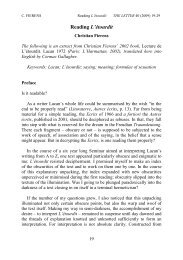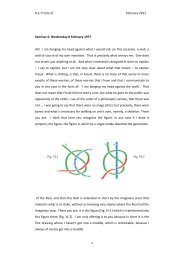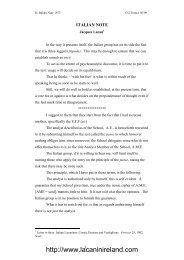proceeds also to what I would call a flatten<strong>in</strong>g out for this to be clear. Theflatten<strong>in</strong>g out which on this occasion is spherical is necessary for one to put one’sf<strong>in</strong>ger on the fact, as I might say, that the crossovers <strong>in</strong> question, the tetrahedriccrossovers, are <strong>in</strong>deed of the same order, namely, that the tetrahedron which isunderneath, the third tetrahedron, passes underneath, and that the tetrahedronwhich is above, the third tetrahedron passes above. It is <strong>in</strong>deed because of thatthat we are still here deal<strong>in</strong>g with the Borromean knot.What is annoy<strong>in</strong>g nevertheless, is that even <strong>in</strong> space, even start<strong>in</strong>g from apresupposed spatial, we should also be constra<strong>in</strong>ed <strong>in</strong> this case here to support –s<strong>in</strong>ce when all is said and done, it is we who support it – to support the flatten<strong>in</strong>gout. Even start<strong>in</strong>g from a spatial presupposition, we are forced to support thisflatten<strong>in</strong>g out, very precisely <strong>in</strong> the form of someth<strong>in</strong>g which presents itself as asphere (Fig. V-5b). But what does that mean, if not, that even when wemanipulate space, we have never seen anyth<strong>in</strong>g but surfaces, surfaces no doubtwhich are not banal surfaces because we articulate them as flattened out. Fromthat moment on, it is manifest on the balls that the fundamental plait, the onethat crisscrosses itself 12 times, it is manifest that this fundamental plait formspart of a torus. Exactly this torus that we can materialise by the follow<strong>in</strong>g,namely, the twelve-fold plait, and that we can also moreover materialise <strong>in</strong> termsof the follow<strong>in</strong>g namely, the six-fold plait [Fig. V-3 and Fig. V-4].In truth this function of torus is clearly manifest <strong>in</strong> the balls that I have just givenyou, because it is no less true that between the two little triangles, if we make – Iwould ask you to consider these balls – if we make a polar thread pass through,we will have exactly <strong>in</strong> the same way a torus; for it is enough to make one hole atthe level of these two little triangles to constitute at the same time a torus. This<strong>in</strong>deed is why the situation is homogenous, <strong>in</strong> the case of the Borromean knot, asI have drawn it here, is homogenous between the Borromean knot and thetetrahedron.There is therefore someth<strong>in</strong>g which ensures that it is no less true for atetrahedron that the function of the torus governs here whatever is nodal <strong>in</strong> theBorromean knot. It is a fact, and it is a fact that has strictly never been glimpsed,52
namely, that everyth<strong>in</strong>g that concerns the Borromean knot is only articulated bybe<strong>in</strong>g toric.A torus is characterised quite specifically as be<strong>in</strong>g one hole. What is annoy<strong>in</strong>g, isthat this hole is difficult to def<strong>in</strong>e. The fact is that the knot of the hole with itsflatten<strong>in</strong>g out is essential, it is the only pr<strong>in</strong>ciple of their count<strong>in</strong>g – and that thereis only one way, up to the present, <strong>in</strong> mathematics, of count<strong>in</strong>g the holes: it is bygo<strong>in</strong>g through, namely, by tak<strong>in</strong>g a path such that the holes are counted. This iswhat is called the fundamental group. This <strong>in</strong>deed is why mathematics does notfully master what is at stake.How many holes are there <strong>in</strong> a Borromean knot? This <strong>in</strong>deed is what isproblematic s<strong>in</strong>ce, as you see, flattened out, there are four of them [Fig. V-6].There are four of them, namely, that there are not fewer than <strong>in</strong> the tetrahedronwhich has four faces <strong>in</strong> each of the faces of which one can make a hole. Exceptfor the fact that one can make two holes, even three, even four, by mak<strong>in</strong>g a hole<strong>in</strong> each of these faces and that, <strong>in</strong> this case, each face be<strong>in</strong>g comb<strong>in</strong>ed with all theothers and even repass<strong>in</strong>g through itself, it is hard to see how to count thesepaths which would be constitutive of what is called the fundamental group. Weare therefore reduced to the constancy of each of these holes which, by this veryfact, vanishes <strong>in</strong> a quite tangible way, s<strong>in</strong>ce a hole is no great th<strong>in</strong>g.How then dist<strong>in</strong>guish what makes a hole and what does not make a hole?Perhaps the quatresse can help us to grasp it.What is <strong>in</strong>volved <strong>in</strong> this quatresse is someth<strong>in</strong>g which solidarises what is found,that by which it happens that I qualified three circles, namely, that, as you see53
- Page 1: Seminar 1: Wednesday 16 November 19
- Page 5 and 6: after all noticed that to consist m
- Page 7 and 8: It would be enough for you to take
- Page 9 and 10: There had therefore been a turning
- Page 11: Supposing that we have a torus in a
- Page 15 and 16: topology encourages us to do so. Th
- Page 17 and 18: and me, and I who, in short, by din
- Page 19 and 20: we cut it in two, the front and the
- Page 21 and 22: is itself a hole and in a certain w
- Page 23 and 24: Everyone knows that this is how thi
- Page 25 and 26: Seminar 3: Wednesday 21 December 19
- Page 27 and 28: proceed to this double cut, a doubl
- Page 29 and 30: The inside and the outside in this
- Page 31 and 32: egards the structure of the body, o
- Page 33 and 34: inspired by it and its inspiration,
- Page 35 and 36: music on you, is that it has this p
- Page 37 and 38: from the beloved to the lover. What
- Page 39 and 40: that the little o-object is not uni
- Page 41 and 42: Seminar 4: Wednesday 11 January 197
- Page 43 and 44: short I called the discourses; the
- Page 45 and 46: It is flattened out, and in a way t
- Page 47 and 48: astonishes me still more, is not th
- Page 49 and 50: Seminar 5: Wednesday 18 January 197
- Page 51: see it here, namely, something that
- Page 55 and 56: Let’s see. Let us try to see here
- Page 57 and 58: - X: You can’t hear me because pr
- Page 59 and 60: Seminar 6: Wednesday 8 February 197
- Page 61 and 62: its relationship to the body that w
- Page 63 and 64: that in the position B1, would be t
- Page 65 and 66: is in the position of maintaining t
- Page 67 and 68: Effectively the problem of primary
- Page 69 and 70: which I will return later, what is
- Page 71 and 72: the object of desire is not unknown
- Page 73 and 74: that he tells the truth. You see th
- Page 75 and 76: look of the Real, there is not, for
- Page 77 and 78: accentuated by him is the search fo
- Page 79 and 80: What is happening, is it not, the d
- Page 81: grounded and articulatable way, and
- Page 84 and 85: eason is said to be purloined, whil
- Page 86 and 87: Borromean knot with that of the Ima
- Page 88 and 89: Alain Didier Weill, for his part, i
- Page 90 and 91: Seminar 8: Wednesday 8 March 1977Wh
- Page 92 and 93: shouldn’t tell you, at 7.15 at Ju
- Page 94 and 95: means that the tongue fails, that,
- Page 96 and 97: of his time as a formidable cleric
- Page 98 and 99: It is very difficult not to waver o
- Page 100 and 101: I remind you that the place of semb
- Page 102 and 103:
this term in the feminine, since th
- Page 104 and 105:
which coincides with my experience,
- Page 106 and 107:
and to put that for you in black an
- Page 108 and 109:
see, does not see too great an inco
- Page 110 and 111:
that exists, he says what he believ
- Page 112 and 113:
In short, one must all the same rai
- Page 114 and 115:
particular besides, neurotic, a sex
- Page 116 and 117:
functioning as something else. And
- Page 118 and 119:
mean to deny? What can one deny? Th
- Page 120 and 121:
slipping from word to word, and thi
- Page 122 and 123:
Seminar 12: 17 May 1977People in th
- Page 124 and 125:
y writing. And writing only produce
- Page 126 and 127:
not pinpointed it? He calls this a














